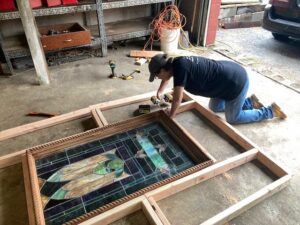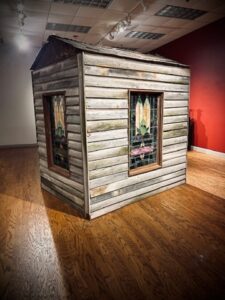calsfoundation@cals.org
Civilizations Don’t Collapse
Recently, I was standing outside an abandoned Presbyterian church in rural Clark County thinking about the collapse of civilizations. Or rather, thinking about how they don’t collapse.

I’d come to this spot two years previously with the artist V. L. Cox, who had secured permission from the Presbyterian synod to remove the stained-glass windows from the church (or what remained of the windows, for some) for use in an art project. It was a hot July day, and the interior of the church was boiling, dusty, and fragrant with rat urine. The building had not been used for congregational purposes for decades, and in the intervening years, farmers and others had used it to store old clothing, rolls of insulation (now decaying), cups and dishes, an odd assortment of board games, glass bottles, and so much more—all of it now covered in layers of dust, because even the newer contents of the church had long been forgotten. When we pried off the windows, we unleashed the wasps that had built a happy home in the frames. We had brought masks to deal with the dust, but the July heat in a wooden building topped with a tin roof made breathing through a mask nigh impossible.
The second visit was to determine how best to salvage some of the wooden structure of the building, for as a whole, the church was a total loss. When we first showed up in 2022, we had to use some doors (loose due to rotted frames) to cover holes in the floor so that we could walk in safety. Though the roof was keeping most of the water out, it had been pulled back in a few places, allowing rain to penetrate the interior. The church was being held up off the ground by strategically placed bricks, some of which had started to crumble, and a local farmer told us that he had already had to prop it up once or twice.
Any church building like this, even (or especially) a small country church that might hold at most fifty people, was at some time a point of pride for a community. But the community had moved on. We know this process well. Sometimes the railroad comes through an area, and people move to be near it. Or a highway. Or, as with Arkansas City, the river shifts and makes your community not quite a port anymore. Or local industries dry up. Or the fields dry up. The company cuts all the timber and moves on, and those towns dry up.
But if you just looked at that abandoned, rotting, overgrown church in isolation, you might assume that something drastic had happened to the local populace, that whatever civilization had existed in that spot had collapsed.
As it happens, I had just listened to a recent episode of one of my favorite podcasts, P3 Dystopia, on this very subject. The series usually tracks ways in which our own societies might become radically undone, either through hackers attacking our infrastructure or some coronal mass ejection knocking out all of our electronics. However, in this particular episode, they went back in time, looking at cases in which past civilizations had ostensibly collapsed. But, as it turns out, most of them simply didn’t.
Rome became the model for civilizational collapse, especially after the Protestant Reformation made anything Roman a byword for degeneracy. Edward Gibbon claimed that the Roman Empire’s embrace of Christianity played a role in its demise by focusing attention upon exclusively otherworldly pursuits, but others have sought to derive a moral lesson from Rome’s decline, highlighting a focus upon “bread and circuses” and the insanity or incompetence of certain later emperors. However, it’s difficult to claim that Rome ever truly disappeared. For starters, the Roman Empire in the East (Byzantium) persisted much longer than it did in the West. Too, many Roman institutions, and the broader culture, were preserved by the Church—Latin remained the language of learning for centuries, and I still remember a retired teacher in rural Mississippi recalling with lamentation the year her little school dispensed with Latin as part of the curriculum.
The Mayan Empire has also been a model for collapse, but this claim does not withstand scrutiny. The first Europeans to find the massive stone structures in Central America, abandoned and overgrown with vegetation, could not believe that the “simple” farmers who lived in the vicinity were the actual inheritors of that culture. The textbooks for some of my early world history classes in grade school presented the Maya as long vanished, lost in the mists of time, despite the fact that Mayan people are still around.
So here was the gist of that episode of P3 Dystopia: What we often want to call civilizational collapse is more often a case of civilizational simplification. See, it takes a lot of resources to support institutions that don’t directly pertain to our ability to live from day to day. A priesthood, libraries, institutions of learning, theaters, and the more ostentatious manifestations of governmental authority (massive buildings, military parades)—these are all expensive. Just as in times of economic recession people spend less on luxury items, so in times of hardship it becomes harder to maintain what doesn’t help you to survive everyday life. A plague that takes out a significant part of the population means that more people will probably need to move into agriculture. Consequently, fewer people will have the opportunity to engage in what Thorstein Veblen called “conspicuous consumption” or to develop what Pierre Bourdieu called “cultural capital.”
Civilization hasn’t necessarily vanished in these places. But in order to persist, the members of that civilization have to focus upon what one cartoon bear memorably dubbed “the bare necessities.”

The reason so many of us who trade in cultural capital are primed to see signs of civilizational collapse through our history is that we equate our own work with the nature of civilization itself. Rather than civilizations being assemblages that allow us all to live a better life than compared with our own isolated efforts, we “educated” folk associate the very essence of civilization with literature, law, and learning. So when we look back and see a decline in respect accorded these things, we say, “Ah, signs of collapse!” And we also tend to look at our present state and see things like the elimination of Latin instruction in secondary schools or the failure of the masses to flock to purchase the latest novel given the National Book Award as similar signs of our own impending downfall.
But much of what we call civilization is luxury. My favorite episode of the British sci-fi sitcom Red Dwarf features our main characters, David Lister and Arnold Rimmer, having crash-landed on a frozen planet and arguing about whether it’s permissible to burn what might be the last extant copy of the complete works of Shakespeare (the rest of the human race having likely gone extinct) in order to survive. It’s a crash course in Maslow’s hierarchy of needs.
Culture is a luxury in such dire situations. Even the Roberts Library and CALS Encyclopedia of Arkansas, no matter how much I hope they will continue (and that I will continue to be employed), are a luxury. And that church, sitting in the middle of a freshly mown field (cut for the hay growing around it), was a luxury. Yes, it was a spiritual home to hundreds of people over the years when it hosted an active congregation. But for a variety of reasons, they moved away and moved on. It’s easy, looking upon a classical wooden rural church, to lament the conditions that drove the people away. However, those people continued to live. They carried those lessons learned and memories made out into a world beyond that corner of Clark County, and so the church and the culture and the community it provided never really disappeared.
People have to live, after all, or what good is everything we call civilization?
By Guy Lancaster, editor of the CALS Encyclopedia of Arkansas



